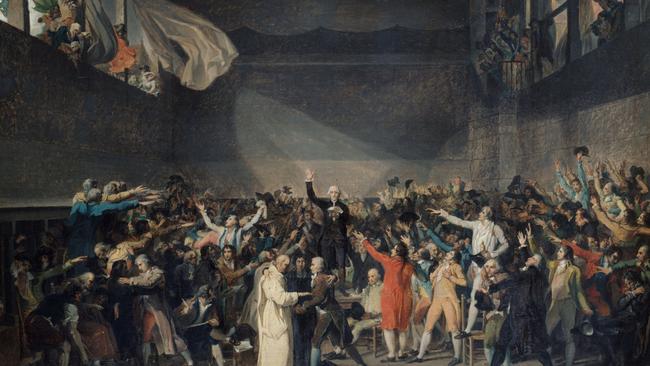Cancel culture and the tyranny of the righteous
Radicalised cancel culture cliques dwell on the theme of oppression but have no realistic theory about how to alleviate it. This is no revolution.

One of the most famous works of art to emerge from the French Revolution is The Tennis Court Oath, Jacques-Louis David’s pen-and-ink sketch of the June 20, 1789, meeting where more than 600 deputies of the Estates-General pledged their “unwavering resolution” to create a new constitution for France.
Five historical figures stand out from David’s sketch. At the centre is the man who’d administered the oath: astronomer, and future Paris mayor, Jean-Sylvain Bailly. To his right is Maximilien Robespierre, the austere teetotaller who would go on to briefly rule France as dictator. Seated before Bailly is the pamphleteer Abbe Emmanuel-Joseph Sieyes. Off to Sieyes’s left, striking an extravagant pose, is the Comte de Mirabeau — who had become a political linchpin of the revolution’s short-lived constitutional period — and Antoine-Pierre-Joseph-Marie Barnave, a member of the revolution’s ruling triumvirate at the time David created his sketch in 1791.
Within three years of taking their oath, all but one of these five men would be dead. Bailly was guillotined in late 1793. Barnave’s head came off two weeks later. Robespierre lost his own the following summer, having already shot away half his jaw in an unsuccessful suicide attempt the day before. Mirabeau, who died of natural causes in 1791, was dug out of a crypt at the Pantheon by a revolutionary mob and flung into an unmarked pit. Of the quintet, only Sieyes would survive to witness the counter-revolutionary period, having had the good sense to give up politics and lie low. When it came to what we now call cancel culture, the Jacobins were world-class experts.
The ideological witch-hunts of our own era, whose victims take centre stage in the Quillette essays reprinted in this anthology, do not herald any kind of equivalent bloodbath. The French Revolution took place against a backdrop of apocalyptic war, famine and devastating economic crises. Life was cheaper then, and it was possible for extremists to justify murder in the name of their beliefs.
The victims of modern cancel culture may lose their jobs, their friends and their reputations. But none will lose their head. Nevertheless, it is useful to look to the French Revolution, as well as similar periods of upheaval, as a means to help us understand today’s radicalised cliques. While Twitter mobs do not command the powers of life and death, their social and ideological dynamics carry unsettling historical overtones. The problem we are experiencing now is not to be confused with literal censorship (except as that term may be applied loosely). Unlike Robespierre and his Committee of Public Safety, modern cancel-culture enforcers typically do not rely on government edict.
Instead, they pursue crowdsourced social-media campaigns aimed at shaming heretics and threatening their professional livelihoods. In this way, such mobs yoke progressive ideology to the inherently conservative social instincts that lead all of us to conform to expectations and align our ideas with those of our neighbours.
Even in the 1940s, George Orwell noted, “the sinister fact about literary censorship in England is that it is largely voluntary.” Yes, you could publish unfashionable opinions, “but to do so was to make sure of being ignored or misrepresented by nearly the whole of the highbrow press. Both publicly and privately you were warned that it was ‘not done’.” Orwell focused on the intellectual cultism that infected the world of high arts and letters not only because this was the world he knew best but also because these rarefied domains lie upstream from education, media, party politics and, ultimately, public opinion.
The radicalisation of today’s progressive left, like the countervailing transformation of the populist right, can’t be described as revolutionary because it doesn’t offer any real alternative to traditional politics. Look beyond the street protests, the vandalised statues, the cancellation campaigns, the exotic theorems of intersectional identity, and one finds that the actual political demands are ludicrous (“abolish the police”), meaningless (“decolonise our cities”) or simply represent further extrapolations of established progressive policies, such as hiring quotas, affirmative action in education and enforced equity-training sessions.
This helps explain why modern social-justice proponents typically seem dour and artistically lifeless compared with their hippie grandparents. They dwell on the theme of oppression but have no realistic theory about how to alleviate it. And since their power typically extends only to the representational aspects of life — the hashtags we are allowed to use, the books we are allowed to write, the clothes we are allowed to wear, the acceptable names for buildings and streets, the pronouns people must recite — these are the subject of their most passionately expressed grievances. Unlike the progressive counterculture of the 1960s, which encouraged sexual openness, flamboyant individualism and euphoric cultural mixing, today’s social-justice crusades are built around joyless rites of self-interrogation, announced publicly but conducted inwardly.

As many have noted, these rituals bear an unsettling resemblance to ersatz religious ceremonies, complete with rites of devotion, penitence, excommunication and even martyrdom. This is not a coincidence. Like the religions they displace, political cults offer adherents a totalising theory of good and evil that conflates ideological correctness with moral worth. Robespierre himself made this connection explicit in his final months, presenting Parisians with an elaborate “Festival of the Supreme Being” (in which he of course presided as high priest). In a speech delivered during this period, he claimed the power to strike down the sinful, defending “terror” as a species of justice that was “prompt, severe and inflexible”, and therefore “an emanation of virtue”.
But, as Orwell noted, political cults diverge from true religions in that their “doctrines are not only unchallengeable but also unstable”. In 1789, a Frenchman could lose his head for denying the legitimacy of monarchism. In 1792, he could suffer the same fate for asserting the opposite. By 1793 and 1794, even the slightest deviation from republican orthodoxy drew furious denunciation by one-time friends and colleagues, which in turn generated a climate of paranoia that destroyed longstanding friendships and empowered the most sociopathic revolutionary elements.
One reason the French Revolution comes up often in any discussion of broad political and ideological trends is that it set the template not only for modern classical liberalism but also for its rejection. In its liberal form, the revolution peaked with the constitution of 1791, which created a democratic constitutional monarchy. But following the execution of Louis XVI, a new constitution was drafted, one whose provisions were permanently suspended amid the Reign of Terror. As with communists, religious fundamentalists, Cold War McCarthyites and autocratic populists, the architects of this terror argued that the republican project was too urgent to be constrained by the need for due process, free speech, the right of assembly or other civil liberties. It’s a theme one often detects among today’s most ardent progressives, who view themselves as vanguard elements in a Manichean battle against racism and fascism.
Another lesson of the French Revolution is that the same communications technologies that permit political dissent and intellectual pluralism also can be co-opted by tyrants and mobs. The seeds of the revolution were planted in the arcades of the Palais-Royal, then under the control of the liberal-minded Louis Philippe II, Duke of Orleans. It was a sort of proto-Reddit in bricks and mortar, an anything-goes zone where rabblerousers could distribute scandalous anti-royalist pamphlets and newspapers, or harangue one another in cafes with political speeches. And it was this plucky ethos that guided the revolution in its early years, and which inspired the Jacobin Club to throw open its doors to the public, so that anyone could walk in and cheer or jeer at speakers. Over time, however, the speakers began reacting to the mob, instead of vice versa. And newspapers published fatwas against any politician deemed guilty of moderantisme.
We often say that Quillette is a place where “free speech lives”. But we also understand that laws and policies that nominally protect free speech don’t guarantee that people can say what they think or that the marketplace of ideas will remain functional. The current wave of crowdsourced dissent-suppression campaigns provides just one of many historical examples that show how free speech depends as much on a hospitable intellectual culture as on legal codes. Education and intellect do not, on their own, protect against ideological autocracy. Just the opposite; habituated to the respect and deference of hoi polloi, the little Robespierres who control university faculties and social-media cliques tend to include some of the most educated members of our society. It is not ignorance that fuels their inquisitions, but hubris and an appetite for power.
One of the problems we face is that intellectual liberty has no dependable constituency, since those who are most in need of it tend to be those who have the least power. Free speech and due process are now often described as conservative values. But not so long ago they were proudly claimed under the liberal banner. As anyone who remembers the rise of the religious right in the 1980s can attest, the reins of cultural power get tossed back and forth in cyclical fashion. And only by internalising history’s lessons can partisans on each side remain grounded in principles that transcend their own fleeting, parochial self-interest.
As in many other spheres of human behaviour, lessons on mob justice learned by one generation must be relearned, the hard way, by the next. As journalists, we find that the best way to explore such lessons is by telling the stories of men and women who’ve been branded, in one way or another, as heretics. Whether or not readers embrace the substance of the heresies described in the essays, we hope their narratives demonstrate why we should not permit ideologues to decide which viewpoints may or may not be expressed. Whether on the hunt for Catholics, Protestants or Jews, royalists or republicans, capitalists or communists, all mobs present themselves as virtue’s servants.
Jonathan Kay is a senior editor at Quillette. This is an edited extract from an anthology of essays by Quillette, titled Panics and Persecutions, published by the Black Spring Press Group. Out on Monday.



To join the conversation, please log in. Don't have an account? Register
Join the conversation, you are commenting as Logout